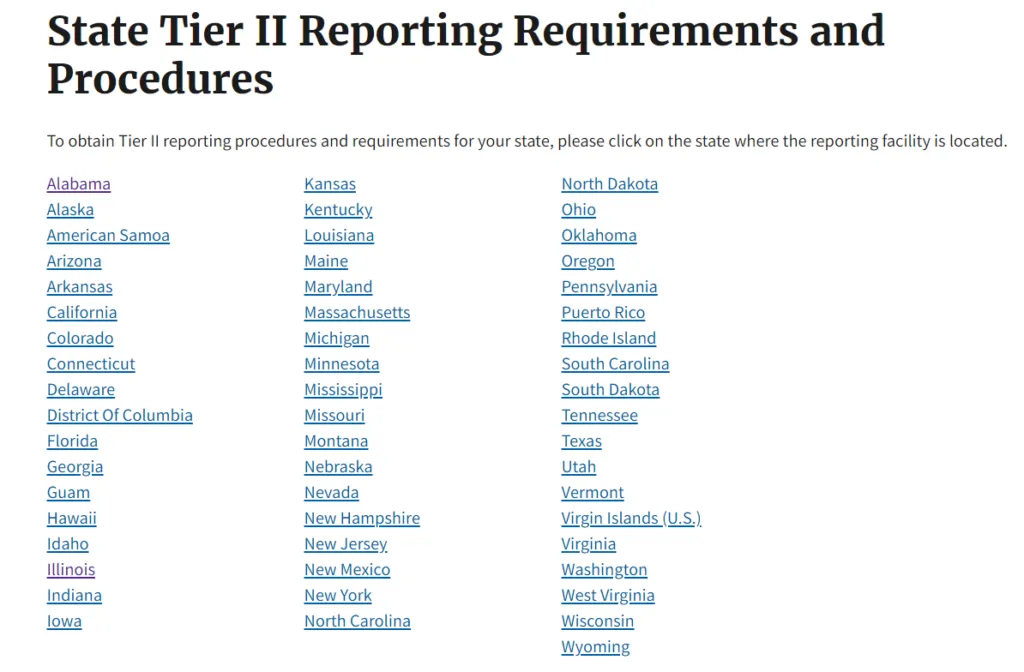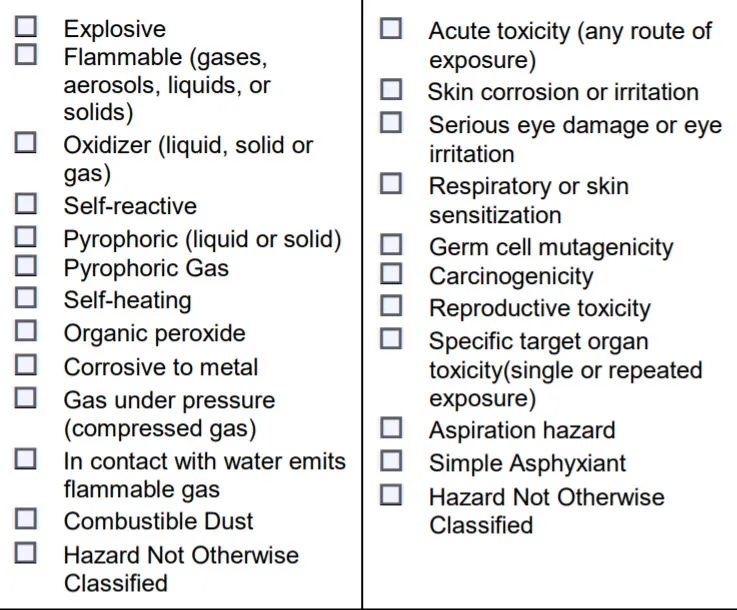Can it be that there’s yet another regulatory reporting deadline approaching? There is, and this time it’s for completion and submission of EPA’s Emergency and Hazardous Chemical Inventory Form (Tier II).
Here, we’ll discuss the basics of Tier II reporting and give you the guidance you need to determine your applicability and correctly submit your reports.
Tier II Regulatory Background
Mandated by Section 311-312 of the Emergency Planning and Community Right-To-Know Act (EPCRA), Tier II reports capture critical information about the types, quantities, and locations of hazardous chemicals at a given facility. The required annual submission of this information is ultimately intended to help local and state emergency responders prepare for chemical emergencies or other incidents that could affect the surrounding communities.
The information in the Tier II report includes the hazardous chemicals stored at the site, the quantities stored, and emergency contact names and phone numbers for each reporting facility. EPCRA was passed in 1986 in response to widespread concerns over the environmental and safety hazards posed by the storage and handling of toxic chemicals. It was an issue brought to the forefront by the 1984 disaster in Bhopal, India in which an accidental release of methylisocyanate during a process safety failure killed upwards of 3,700 people within hours of the release. Some media reports placed the immediate death toll anywhere between 16,000 and 30,000, and nearly 40 years later, it is estimated that between 500,000 and 600,000 people were killed or injured due to the incident. It is widely regarded as the worst industrial disaster in history.
Do I Need to Report?
You’ll need to complete a Tier II report if you stored more than a given threshold amount of a particular hazardous chemical within your facility at any one point in time during 2021. EPA relies on the definition of a hazardous chemical within OSHA’s HazCom Standard, so it’s important to be familiar with that regulation, especially the “scope and application” section in 1910.1200 (b). In short, if the HazCom Standard requires you to have a safety data sheet (SDS) for a chemical, that chemical is potentially subject to Tier II reporting requirements.
Regarding threshold amounts, the test is whether the chemical was present in your inventory last year, at any one time, in a quantity above the published reporting threshold. For most hazardous chemicals, the threshold is 10,000 pounds, but there are several special considerations:
- If you store chemicals that EPA lists as extremely hazardous substances (EHSs), you’ll have a lower reporting threshold of 500 pounds or the chemical’s listed threshold planning quantity (TPQ), whichever is lower. You can find the full, most current list of EHSs and their associated TPQs in 40 CFR 355 Appendix A and Appendix B – the former lists them in alphabetical order, while the latter lists them by Chemical Abstract System (CAS) number.
- If you store gasoline in underground storage tanks (USTs) in compliance with applicable EPA UST regulations, such as at a retail gas station, the reporting threshold is 75,000 gallons across all fuel grades combined.
- If you store diesel fuel in USTs in compliance with applicable EPA UST regulations at a retail gas station, the reporting threshold is 100,000 gallons across all grades combined.
Ultimately, your Tier II report would need to include all chemicals you had in your inventory during 2021 that exceeded their reporting threshold.
These are the federal EPA requirements, and most states have adopted them. But remember, state EPAs can choose to adopt more stringent versions of regulations than those at the federal level, and some states have additional reporting requirements for other chemicals. For example, facility managers in Alaska would, in addition to meeting the federal requirements, need to report any quantity of hazardous materials identified in federal placarding regulations as Poison Gas (2.3), Poisons (6.1), Explosives (1.1, 1.2, 1.3), Flammable Solid (*4.1-4.3) and Radioactive Hazard Class 7.
That leads us to an important point that will come up a couple of more times in this article: you need to understand your state-specific reporting requirements (if any) very early in your Tier II reporting cycle. EPA maintains a landing page containing state requirements here. Once there, you’ll find a page that looks like the screen capture below, and then you can look up details for your state.

Are There Any Exceptions to Reporting Requirements?
Yes, there are a number of exceptions listed in EPCRA Section 311(e). The following chemicals are exempt from Tier II reporting:
- Any food, food additive, color additive, drug, or cosmetic regulated by the Food and Drug Administration (FDA);
- Any substance present as a solid in any manufactured item to the extent exposure to the substance does not occur under normal conditions of use;
- Any substance to the extent it is used for personal, family, or household purposes, or is present in the same form and concentration as a product packaged for distribution and use by the general public;
- Any substance to the extent it is used in a research laboratory or a hospital or other medical facility under the direct supervision of a technically qualified individual; and
- Any substance to the extent it is used in routine agricultural operations or is a fertilizer held for sale by a retailer to the ultimate customer
Here we can see another connection between EPA’s Tier II requirements and OSHA’s HazCom Standard. Those of you familiar with OSHA’s list of exemptions to HazCom Standard in 1910.1200(b)(6) will recognize some of the items on the list above. For example, the Tier II exemption for food products, drugs, and cosmetics regulated by the FDA corresponds with similar HazCom exemptions in 1910.1200 (b)(6)(vi)-(viii). The Tier II exemption for consumer products corresponds to the HazCom exemption for the same in 1910.1200 (b)(6)(ix).
This reinforces the point that EPA’s definition of a hazardous chemical subject to Tier II reporting is grounded in OSHA’s definition of chemicals subject to HazCom. In turn, this may help us recognize how EPA Tier II compliance is going to depend on how well we’re meeting our HazCom obligations. Without an up-to-date chemical inventory list and access to hazard information on our SDSs, we don’t even have a good place to start.
When is the Tier II Report Due?
If you’re subject to EPCRA Tier II reporting requirements, you’ll need to complete and submit the report by March 1. The annual deadline is March 1 for chemicals stored during the previous calendar year.
How Do I Complete the Tier II Report?
This is an important question, and it’s another time you’re going to want to be sure you understand your state-specific reporting requirements. When you click on your state at this page, you’ll see information you’ll need, including whether your state accepts physical Tier II forms, or the specific kind of software platform or web portal you’ll need to use to complete your reports.
For example, you’ll find that most states accept reports through the EPA-provided Tier2 Submit software. But not all states accept Tier2 Submit – my own state of Illinois only accepts forms completing using Illinois Emergency Management Agency’s (IEMA) Tier II Manager On-Line Filing System.
Whether you need to use Tier2 Submit or a state-specific software platform, you’ll want to make sure to download and use the latest version. EPA released the latest version of Tier2 Submit late last year, and has provided a tutorial on its use.
In the event you submit your Tier II reports using the hard-copy Tier II forms, you’ll also want to make sure you’re using the most current version. The current forms use the same physical and health hazard categories in OSHA’s HazCom Standard (another intersection point!), which means that it’s easy to fill out that section of the Tier II using the SDSs for your chemicals. The chart below shows the current HazCom-aligned physical and health hazard categories on the Tier II form.

Where Do I Send the Report?
You’ll need to send your EPCRA Tier II report to three main recipients on or before the reporting deadline:
- Your State Emergency Response Commission (SERC)
- Your Local Emergency Response Committee (LEPC)
- The local fire department and/or first responder agencies with jurisdiction over your facility
Here’s an important point to remember: If you’re using the Tier 2 Submit software, the software will help you complete and validate the report and save the file on your computer, but it doesn’t actually send the report anywhere. You will need to do that. That’s another reason it’s very important to know the SERC, LEPC and local fire department for each of your reporting facilities.
You can find out the name and address of your SERC by visiting that same state-specific reporting page we’ve talked about a couple of times already. Once you’ve identified your SERC, you can contact them to identify and contact your LEPC.
That just leaves the matter of identifying your local fire department and first responder agencies. Hopefully you already know which ones have jurisdiction over your facility, and have an established relationship with them. After all, that’s a key part of a sound emergency planning approach. If not, you can identify the fire departments and first responders closest to you and contact them to directly ask them about their jurisdiction. Once you learn that, you can start building your organization’s relationship with them.
Speaking of that, here’s one last tip. While not all states require you to submit a site map/facility layout diagram with your Tier II report, it’s a good idea to do so. Why? Because it gives the first responders who may be arriving at your facility in an emergency a higher level of information about the chemicals you store and where and how you store them. This will ultimately help achieve a safer and more efficient emergency response if, and when it needs to happen. If you were a first responder, wouldn’t you want that? If your business depends on the actions of first responders to protect your life and your business in the event of an emergency, you should probably want that too, right?
SaaS solutions like VelocityEHS Chemical Management can make it easy to not only have the visibility of your chemical inventory and SDS library you need to complete your Tier II reporting, but also map your chemical storage locations onto a virtual site plan of your facility. From there you can either include it in your electronic submission, or print and include with your hard copies, depending on the submission formats and systems in your state.
Looking for More Information?
Check out the EPA’s Tier II reporting page for more information that may help you through all stages of the reporting process.
If you’re looking for an even deeper dive into EPCRA Tier II reporting including detailed discussions of Tier II exemptions, tips for accurate reporting and how to use the Tier2 Submit software, check out our upcoming live webinar on February 22, 2022 at 11am ET. Register at the link below!
FREE WEBINAR: EPA Tier II Reporting: How to Ensure Compliance
Let VelocityEHS Help!
Compliance with EPA EPCRA Tier II reporting depends on getting your OSHA HazCom and chemical management obligations right. If you’d like to learn more about how our Chemical Management software can help streamline your chemical inventory management and automate EPA EPCRA Tier II reporting, visit our solution landing page for more information. As always, please feel free to contact us anytime.
